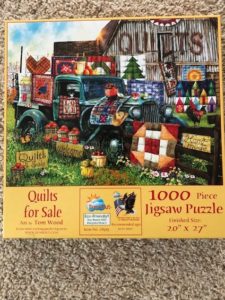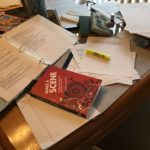I love it when an extended metaphor successfully works from beginning to end. Unfortunately, this is where my novel and puzzle connection totally fall apart.
 Once I finish a puzzle, it’s done. I might glue it and hang it on a wall or wrap it up in a puzzle holder or pull it all apart and send the pieces off to Cousin Christie who is a quilter (unlike me) so she can have the fun of putting together 1,000 pieces.
Once I finish a puzzle, it’s done. I might glue it and hang it on a wall or wrap it up in a puzzle holder or pull it all apart and send the pieces off to Cousin Christie who is a quilter (unlike me) so she can have the fun of putting together 1,000 pieces.
That is totally unlike writing a novel. Once I finish writing the first draft, the fun has only begun. Now I have editing, adding threads of themes or subplots here and there, putting in some red herrings to throw my reader off the scent, or fixing all those pesky errors that I knew I made when I wrote the darn thing. And yes, I do chuckle with a villainous laugh when I add those false clues. A clue or two here or there to play fair with my reader is also a consideration once I begin editing. Seriously, that jigsaw puzzle is looking better and better as a project with definite closure.
After I’ve checked the content to make sure I didn’t leave a huge plot hole here or there, I still have that list of what I call “weasel words.” Those are words I habitually use that mean nothing. Here are some lovely examples: really, very, that, then, kind of, pretty, so. That’s only the beginning. Doing a “find” search on my computer points out the little devils. My brain must then figure out how to reword or rewrite. Thank goodness for computer searches.
 Next, we have the parts of speech—you know, those silly things your English teacher made you memorize in school, beginning with nouns and verbs. I check for strong verbs first. If I have used an ordinary verb in my haste to get that first draft finished—say, “walked”—I might want to replace it with strolled, sauntered, tiptoed, or trudged. A specific verb can shine a light on the mindset of the character doing the walking. Verbs are followed by adjectives and adverbs, the curse of the action writer. In my case, descriptions of places and people are tough without them. But no overdoing.
Next, we have the parts of speech—you know, those silly things your English teacher made you memorize in school, beginning with nouns and verbs. I check for strong verbs first. If I have used an ordinary verb in my haste to get that first draft finished—say, “walked”—I might want to replace it with strolled, sauntered, tiptoed, or trudged. A specific verb can shine a light on the mindset of the character doing the walking. Verbs are followed by adjectives and adverbs, the curse of the action writer. In my case, descriptions of places and people are tough without them. But no overdoing.
Another pass over the entire novel involves sentence beginnings and endings. If multiple sentences close together begin with “I,” I have a problem. I’m looking at 80,000 words and considering each sentence. One at a time. 80,000 times. This, of course, is the part that’s fun. Not.
After all of this, when I have the draft polished, prodded, petted, and primped so I know it is perfect, I send if off to my editor who finds boatloads of errors I missed. (Key the music here for former English students of mine to laugh.) My editor assures me that she points these mistakes out with love, and if I wrote a perfect draft I wouldn’t need her. That has not yet happened. She has job security.
who finds boatloads of errors I missed. (Key the music here for former English students of mine to laugh.) My editor assures me that she points these mistakes out with love, and if I wrote a perfect draft I wouldn’t need her. That has not yet happened. She has job security.
Once I’ve finished polishing the draft with my editor, I begin calling it “my manuscript.” Now, it’s time to send it out to publishers, and that’s a whole new story. You might remember, the puzzle ended up at the top of this post, but the finished product—the book–appears to go on and on …


